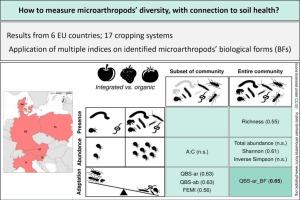Estimating the microarthropod diversity in cropping systems by comparing ecological indices across Europe
IF 5
2区 农林科学
Q1 SOIL SCIENCE
引用次数: 0
Abstract
Microarthropods are pivotal components of the soil mesofauna, significantly contributing to the enhancement of soil quality and structural properties. The evaluation of microarthropod diversity provides valuable information on soil health, owing to their contribution to specific ecosystem services of soil. To monitor mesofauna diversity, the definition and validation of structural ecological indices capable of comprehensively assessing microarthropod community diversity and functionality is needed. In this work, several ecological indices (Hill's number, Acari:Collembola, QBS-ar, FEMI, QBS-ab) based on microarthropod biological forms (BFs) were applied to evaluate soil mesofauna biodiversity in 17 agroecosystem sites under either organic or integrated management. In addition, a novel calculation of the QBS-ar, which consider all observed BFs, called QBS-ar_BF, was proposed and compared to the other indices. The frequency and abundance of BFs highly adapted to soil life differ between management systems (integrated < organic) and crop duration (pluriannual > annual). Overall, the indices that best discriminated the different management in cropping systems were those based on the QBS approach (QBS-ar and QBS-ar_BF) . Moreover, the newly developed QBS-ar_BF index highlighted a higher discrimination capacity due to its inclusion of all observed BFs, i.e. all microarthropod community spectrum information. This study confirmed the pivotal role of edaphic mesofauna in highlighting the differences between soil management and crops across Europe, opening perspectives to new monitoring frameworks to detect shifts in community structure and functional traits.

通过比较欧洲各地的生态指数估算耕作系统中微型节肢动物的多样性
微节肢动物是土壤中系动物的重要组成部分,对土壤质量和结构特性的改善具有重要作用。由于小节肢动物对土壤特定生态系统服务的贡献,对其多样性的评价为土壤健康提供了有价值的信息。为了监测中系动物多样性,需要定义和验证能够综合评价微节肢动物群落多样性和功能的结构生态指标。采用基于小节肢动物生物形态(BFs)的Hill’s number、Acari:弹虫、QBS-ar、FEMI、QBS-ab等生态指标,对17个农业生态系统样点在有机管理和综合管理下的土壤中系动物生物多样性进行了评价。此外,提出了一种新的QBS-ar计算方法,即QBS-ar_BF,该方法考虑了所有观测到的BFs,并与其他指标进行了比较。高度适应土壤生活的生物多样性的频率和丰度因管理制度(综合有机)和作物种植年限(多年生)而异。总体而言,基于QBS方法的指标(QBS-ar和QBS- ar_bf)最能区分种植制度的不同管理方式。此外,新建立的QBS-ar_BF指数由于包含了所有观测到的BFs,即所有微小节肢动物群落的光谱信息,因此具有较高的识别能力。这项研究证实了土壤中系动物在突出整个欧洲土壤管理和作物之间差异方面的关键作用,为新的监测框架开辟了视角,以检测群落结构和功能性状的变化。
本文章由计算机程序翻译,如有差异,请以英文原文为准。
求助全文
约1分钟内获得全文
求助全文
来源期刊

Applied Soil Ecology
农林科学-土壤科学
CiteScore
9.70
自引率
4.20%
发文量
363
审稿时长
5.3 months
期刊介绍:
Applied Soil Ecology addresses the role of soil organisms and their interactions in relation to: sustainability and productivity, nutrient cycling and other soil processes, the maintenance of soil functions, the impact of human activities on soil ecosystems and bio(techno)logical control of soil-inhabiting pests, diseases and weeds.
 求助内容:
求助内容: 应助结果提醒方式:
应助结果提醒方式:


